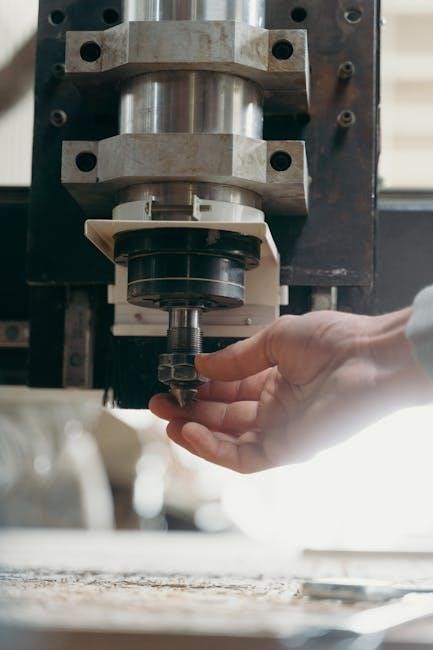The Cessna 172M Parts Manual is an essential resource for identifying and procuring components for the Cessna 172 and 172 Skyhawk aircraft models. It provides detailed illustrations and part numbers, including standard parts designated with the Sff prefix, ensuring accurate maintenance and repairs. This comprehensive catalog covers various aircraft systems, aiding mechanics and owners in efficiently managing replacements and upgrades.
Importance of the Parts Manual for Maintenance and Repair

The Cessna 172M Parts Manual is indispensable for ensuring the airworthiness and safety of the aircraft. It provides detailed part numbers, illustrations, and descriptions, enabling mechanics to identify components quickly and accurately. This manual is crucial for routine maintenance, repairs, and upgrades, as it ensures compliance with aviation standards. By referencing the catalog, technicians can verify the authenticity and compatibility of parts, reducing the risk of errors. The manual also aids in troubleshooting by providing a clear understanding of system components. Regular updates and revisions ensure the information remains current, making it a vital tool for maintaining operational efficiency and safety. Proper use of the manual helps extend the aircraft’s lifespan and ensures adherence to regulatory requirements, making it an essential resource for owners and maintenance professionals.

Airframe Systems
The Cessna 172M Parts Manual details the airframe’s structural components, including the fuselage, wings, and landing gear. It lists standard parts like Sff components, ensuring accurate identification and procurement for maintenance and repairs, critical for safety and structural integrity.
Fuselage Components
The Cessna 172M Parts Manual provides detailed information on the fuselage, a critical structural component of the aircraft. It includes descriptions of frames, skin panels, and door assemblies, all essential for maintaining the aircraft’s integrity. The manual lists standard parts, such as those with the Sff prefix, ensuring easy identification and procurement. Fuselage components are fabricated from durable materials like aluminum alloys, designed to withstand various flight conditions. The manual also covers access panels, windows, and other structural elements, aiding mechanics in routine inspections and repairs. This section is vital for ensuring the fuselage remains airworthy, maintaining safety and performance. By referencing this guide, technicians can efficiently locate and replace parts, minimizing downtime and ensuring compliance with aviation standards. The fuselage’s design and components are central to the aircraft’s overall functionality and longevity.

Wing Structure and Parts
The wing structure of the Cessna 172M is a critical component, designed for strength and aerodynamic efficiency. The manual details the wing’s framework, including spars, ribs, and skin panels, all made from durable materials like aluminum alloys. It also covers control surfaces such as flaps and ailerons, essential for flight control. The parts catalog lists standard components, including those with the Sff prefix, ensuring easy identification and procurement. The wing’s design incorporates fuel tanks and landing gear attachments, with the manual providing specifications for inspections and repairs. This section is vital for maintaining the wing’s structural integrity and ensuring safe flight operations. By referencing this guide, technicians can efficiently manage wing-related maintenance, repairs, and upgrades, adhering to aviation standards for optimal performance and safety. The wing’s durability and reliability are central to the aircraft’s overall functionality.
Landing Gear and Related Components
The landing gear of the Cessna 172M is a sturdy, fixed-tricycle system designed for durability and stability during takeoffs, landings, and taxiing. The manual provides detailed specifications for the main gear, nose gear, and associated components like oleo struts, wheels, and brakes. It also covers the electrical and hydraulic systems that control gear retraction and extension. The parts catalog includes standard components, such as those with the Sff prefix, ensuring easy identification and procurement. Regular inspection and maintenance of these parts are critical to prevent wear and tear, which could lead to system failure. The manual emphasizes proper lubrication, tire pressure checks, and brake pad replacements to ensure safe operations. Properly maintained landing gear is essential for the aircraft’s overall performance and safety, making this section of the manual indispensable for technicians and owners. Neglecting these components can lead to costly repairs and potential safety hazards.
Engine and Propeller
The Cessna 172M is powered by a reliable Lycoming O-320-E2D engine, with the manual detailing its major components and maintenance requirements. The propeller system, including controls, ensures optimal performance and efficiency, with standard parts like those in the Sff group aiding in repairs and replacements. This section is crucial for understanding and maintaining the aircraft’s powerplant, ensuring safe and efficient operation. Regular inspections and adherence to the manual’s guidelines are essential for longevity and reliability. Proper engine and propeller maintenance is vital for overall aircraft performance and safety, making this section indispensable for technicians and owners alike. Adhering to the manual’s specifications ensures compliance with aviation standards and prevents potential failures.

Engine Overview and Major Components
The Cessna 172M is equipped with a Lycoming O-320-E2D engine, a four-cylinder, air-cooled, horizontally opposed aircraft engine. This engine is known for its reliability and durability, making it a cornerstone of the aircraft’s performance. The manual provides detailed specifications, including the engine’s power output, fuel system, and cooling mechanisms. Major components include the cylinders, crankcase, camshaft, and accessories like the magneto and carburetor. The propeller system, controlled by the engine, is also covered, with parts cataloged for easy identification. Standard parts, such as those in the Sff group, simplify maintenance and repairs. Understanding these components is crucial for proper engine operation, routine inspections, and troubleshooting. The manual ensures technicians and owners can maintain the engine efficiently, adhering to aviation standards for safety and longevity.
Propeller Systems and Controls
The Cessna 172M features a fixed-pitch propeller or an optional constant-speed propeller, depending on the model year and configuration. The propeller system is integral to the aircraft’s performance, providing the necessary thrust for takeoff, climb, and cruise. The manual details the propeller assembly, including the spinner, blades, and hub, along with associated control mechanisms. It also covers the propeller governor and pitch control systems, which regulate blade angle for optimal efficiency. Standard parts, such as those in the Sff group, are highlighted for easy identification and replacement. The manual ensures technicians can perform routine inspections, repairs, and adjustments to maintain proper propeller function. This section is critical for ensuring the propeller operates safely and efficiently, adhering to aviation standards and extending the lifespan of the aircraft.

Avionics and Electrical Systems
The Cessna 172M Parts Manual details the avionics and electrical systems, including standard parts like those in the Sff group, essential for maintaining and upgrading the aircraft’s electronic infrastructure.
Electrical System Components
The Cessna 172M Parts Manual provides detailed information on the aircraft’s electrical system components, including circuit breakers, wiring harnesses, and power distribution units. It lists standard parts, such as those in the Sff group, which are essential for maintaining the electrical infrastructure. The manual also covers components like alternators, voltage regulators, and electrical connectors, ensuring accurate identification and replacement. By referencing this guide, mechanics can efficiently troubleshoot and repair electrical issues, ensuring the aircraft’s systems operate safely and efficiently. The manual’s comprehensive catalog simplifies the process of sourcing genuine or compatible parts, adhering to aviation standards for reliability and performance.
Avionics Equipment and Interfaces
The Cessna 172M Parts Manual includes detailed specifications for avionics equipment and interfaces, ensuring compatibility and proper integration with the aircraft’s systems. It covers essential components such as communication radios, navigation systems, and flight instruments, providing part numbers and installation guidelines. The manual also addresses interfaces for GPS, autopilot systems, and other advanced avionics, ensuring seamless functionality. By referencing this guide, technicians can identify and replace avionics components accurately, maintaining the aircraft’s operational efficiency and safety. The manual’s comprehensive approach to avionics ensures that all systems are up-to-date and compliant with aviation standards, supporting reliable performance in various flight conditions.

Flight Control Systems
The Cessna 172M Parts Manual details the aircraft’s flight control systems, including ailerons, elevators, and rudder components. It provides part numbers and maintenance guidelines for these critical systems, ensuring proper functionality and safety during flight operations. The manual emphasizes standardization in parts design and replacement, facilitating efficient repairs and upgrades. By adhering to the specifications outlined, technicians can maintain optimal control system performance, crucial for precise aircraft maneuverability and stability.
Primary Flight Controls
The Cessna 172M Parts Manual provides detailed information on primary flight control components, including ailerons, elevators, and rudder systems. These components are essential for aircraft maneuverability and stability. The manual includes part numbers, illustrations, and maintenance guidelines to ensure proper functionality. Standardized parts, such as those with the Sff prefix, simplify identification and procurement. The manual also covers control surfaces, linkages, and actuation mechanisms, emphasizing their critical role in flight safety. By following the guidelines, technicians can perform accurate repairs and replacements, maintaining optimal performance. The manual’s organized structure allows for quick reference, making it an indispensable tool for maintaining the integrity of the aircraft’s primary flight control systems. This ensures compliance with aviation standards and enhances overall flight safety. Regular inspection and maintenance of these components are stressed to prevent operational issues.

Secondary Flight Controls
The Cessna 172M Parts Manual details secondary flight control components, such as flaps, trim tabs, and spoilers, which enhance aircraft performance and handling. These systems are crucial for pilots to manage lift, drag, and roll during various flight phases. The manual provides part numbers, diagrams, and maintenance instructions for these components, ensuring proper functionality. Standardized parts, marked with the Sff prefix, are highlighted for easy identification. The manual also covers actuation mechanisms and linkages, emphasizing their role in precise control. Regular inspection and adjustment of these components are recommended to maintain optimal performance. By adhering to the manual’s guidelines, technicians can ensure compliance with aviation standards, enhancing safety and reliability. The detailed documentation allows for efficient troubleshooting and repair, making it a vital resource for maintaining secondary flight control systems. Proper maintenance of these components is essential for consistent and safe flight operations.
Maintenance and Repair Guidelines
The Cessna 172M Parts Manual outlines essential maintenance and repair procedures, ensuring compliance with aviation standards. It provides detailed schedules for routine inspections, part replacements, and system overhauls, promoting safety and reliability.
Routine Maintenance Procedures
Routine maintenance is critical for ensuring the airworthiness and reliability of the Cessna 172M. The parts manual provides detailed schedules and procedures for regular inspections, lubrication, and component checks. Pre-flight inspections, 50-hour, and 100-hour checks are outlined, covering areas like control surfaces, landing gear, and engine systems. The manual emphasizes the importance of adhering to these routines to prevent wear and tear. Additionally, it specifies intervals for replacing seals, gaskets, and other wearable parts, ensuring optimal performance. By following these guidelines, mechanics can identify potential issues early, reducing downtime and enhancing safety. The Cessna 172M Parts Manual serves as a cornerstone for maintaining the aircraft’s integrity, making it an indispensable tool for owners and maintenance professionals alike. Its clear instructions and standardized procedures streamline the maintenance process, ensuring compliance with aviation standards.

Repair and Replacement Intervals
The Cessna 172M Parts Manual outlines specific intervals for repairing and replacing components to ensure the aircraft’s airworthiness. Routine inspections and scheduled maintenance are detailed, with clear guidelines for replacing parts like tires, brakes, and engine components. The manual specifies intervals based on flight hours or cycles, helping to prevent premature wear. For example, engine oil changes are recommended every 50 hours, while spark plugs should be replaced every 500 hours. Additionally, it provides timelines for inspecting and replacing critical systems like fuel pumps and landing gear components. Adhering to these intervals ensures safety and compliance with aviation standards. The manual also includes diagrams and charts to help mechanics quickly identify parts needing attention, making it an essential resource for maintaining the aircraft’s performance and longevity. Regular adherence to these schedules minimizes downtime and extends the lifespan of the aircraft.
Troubleshooting Common Issues
The Cessna 172M Parts Manual provides detailed diagnostic tools and techniques to identify and resolve common faults, ensuring efficient troubleshooting and maintaining aircraft performance and safety standards.
Identifying Common Faults
The Cessna 172M Parts Manual aids in identifying common faults by providing detailed part descriptions and diagnostic guidelines. It highlights issues related to fuselage components, wing structures, and landing gear, ensuring quick resolution. The manual also covers engine and propeller malfunctions, offering part numbers for replacements. Standard parts, marked with the Sff prefix, simplify identification. By referencing this catalog, mechanics can pinpoint faults efficiently, ensuring aircraft safety and performance. The manual’s structured format allows for easy navigation, making it an indispensable tool for maintenance and repair. Its comprehensive coverage of systems ensures that no potential issue is overlooked, fostering reliability and compliance with aviation standards. This resource is crucial for maintaining the Cessna 172M’s operational integrity.
Diagnostic Tools and Techniques
The Cessna 172M Parts Manual provides essential diagnostic tools and techniques to identify and address aircraft issues. It includes detailed part descriptions, illustrations, and troubleshooting guides to help mechanics locate faults quickly. The manual emphasizes the use of specialized tools like multimeters and hydraulic pressure testers for accurate diagnostics. Additionally, it outlines visual inspection procedures for components such as the fuselage, wings, and landing gear. By cross-referencing part numbers and standard components (marked with the Sff prefix), technicians can efficiently pinpoint malfunctions. The manual also recommends systematic approaches to diagnosing electrical and avionics systems, ensuring comprehensive fault identification. These techniques, combined with the catalog’s detailed information, enable effective troubleshooting and maintenance, ensuring the aircraft’s airworthiness and performance. This section is vital for maintaining operational safety and efficiency.

Legal and Regulatory Considerations
The Cessna 172M Parts Manual ensures compliance with aviation standards, requiring adherence to specific regulations and proper documentation for maintenance and repairs, guaranteeing safety and legal adherence.
Compliance with Aviation Standards
The Cessna 172M Parts Manual ensures adherence to strict aviation regulations, providing detailed guidelines for maintaining compliance with standards set by aviation authorities like the FAA. It outlines specific requirements for parts replacement, inspection intervals, and documentation to guarantee airworthiness. The manual emphasizes the importance of using approved parts and following certified procedures to meet safety and legal obligations. Proper compliance not only ensures operational safety but also avoids legal penalties and maintains the aircraft’s certification. By adhering to the manual’s instructions, owners and maintenance personnel can confidently operate the aircraft within regulatory frameworks. This section underscores the critical role of the parts manual in upholding aviation standards and ensuring the integrity of the aircraft’s maintenance history.
Documentation and Record-Keeping
Proper documentation and record-keeping are critical for maintaining the airworthiness and operational history of the Cessna 172M. The parts manual emphasizes the importance of detailed logs for all parts replacements, inspections, and maintenance activities. Accurate records ensure compliance with aviation regulations and provide a clear audit trail for inspections and audits. The manual recommends maintaining both digital and physical copies of all documentation, including part numbers, installation dates, and servicing history. This ensures that all maintenance actions are traceable and verifiable. Proper record-keeping also aids in tracking the lifespan of components, ensuring timely replacements and preventing operational disruptions. By adhering to the manual’s guidelines, owners and maintenance personnel can maintain a comprehensive and organized record of the aircraft’s maintenance history, which is essential for legal compliance and long-term aircraft integrity.